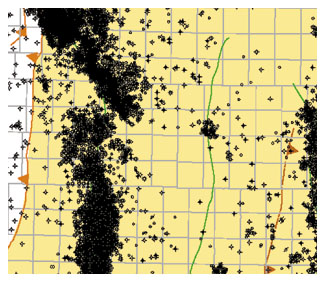| Kestrel Energy & WhiteStar Mix Well in High-Tech Recipe for Success
By Douglas E. Lierle  Ira Pasternack was among the very first geologists to use a computer workstation as a primary tool for oil and gas exploration. Regarded among his peers as one of the industry's most computer-literate geologists, this former Amoco employee understands the value that advanced technology brings to the business of producing energy, especially for small oil and gas companies trying to compete with the "big boys." Ira Pasternack was among the very first geologists to use a computer workstation as a primary tool for oil and gas exploration. Regarded among his peers as one of the industry's most computer-literate geologists, this former Amoco employee understands the value that advanced technology brings to the business of producing energy, especially for small oil and gas companies trying to compete with the "big boys."
Today, as vice president of exploration for Kestrel Energy in Denver, Pasternack and his colleagues use state-of-the-art geoscience software products to integrate and interpret vast amounts of data that result in sound, timely decisions. Kestrel's high-tech recipe for success includes the combined capabilities of GeoPlus Petra geological software and the Seismic Micro-Technology Kingdom Suite geophysical program.
These PC-based software programs enable Pasternack to manipulate, integrate and intepret the primary elements of data that are vital to Kestrel's exploration efforts: well information - complete with historic, operator, and latitude and longitude data; well logs in a raster format - Kestrel can purchase logs in a raster format for between $3 and $4 per well versus $300 to $400 per well for digital logs; seismic data; and the Public Land Survey from WhiteStar Corporation - a digital file of the Congressional survey system used for spotting wells in much of the United States.
"Having a single, integrated PC-based tool for geological interpretations is crucial to our success," said Pasternack, "and the Public Land Survey is a fundamental piece of the puzzle that helps us perform quick, efficient interpretations in a digital domain. We can create maps and cross-sections with just one geoscientist at a pace equal to that of much larger exploration departments, allowing us to compete with the biggest oil and gas companies in the industry.
"The Kingdom Suite facilitates quick and accurate interpretation of Kestrel's 3D seismic data," Pasternack continued. "Petra enables unhampered import or export of disparate data types and formats while managing the data so that it's well organized and readily accessible. I can easily work back and forth between cross section and map perspectives in an iterative and interactive fashion. Petra's ability to generate excellent quality displays, particularly the color-filled cross sections, helps create effective management and/or investor reviews."
Kestrel Energy is currently developing a natural gas asset base in Wyoming's prolific Green River Basin, where the company holds exploration rights to approximately 25,000 acres. Kestrel has drilled two wells as of June 2000, and also shot a 25-square-mile 3D seismic survey and built a 17-mile pipeline. One prospect identified within the company's acreage has estimated possible reserves of 47 billion cubic feet of gas (BCFG) gross, with 33 BCFG net to Kestrel.
"Successfully developing our holdings in the Green River Basin depends heavily upon technology and accurate interpretations," said Pasternack. "Because we're a small shop, the immediate availability of data is critical to our efforts. When we first ordered digital land grids from WhiteStar, we received the data via e-mail the very same day. When ordering additional data, WhiteStar creates the exact area I need so we can add it to the Public Land Survey previously acquired. In addition, the quality is excellent. We can overlay WhiteStar's digital land grid on a topo map and it conforms very well."
WhiteStar uses powerful GIS technology to merge, polygonize and attribute Public Land Survey from a variety of sources. The data are available at both the 1:100,000 and 1:24,000 scales, and each scale includes section lines, township boundaries, and associated text-label information.
The WhiteStar Public Land Survey databases represent a seamless, complete, industry-standard approach for a wide variety of mapping needs. The data can be integrated with other WhiteStar products such as Digital Elevation Models, the Texas Land Survey, and the Enhanced Culture Database. All databases are compatible with their GeoGraphix LeaseMap module.
Another such tool from WhiteStar, eminently useful in this area, is the newly released OrthoStar™ Compressed Digital Imagery Database. This OrthoStar product consists of more than 150,000 black-and-white aerial photographic quarter quadrangles as produced by the U.S.G.S. OrthoStar imagery is available in the geo-referenced MrSID® image format. This image-compression technology by LizardTech (Seattle, Wash.) reduces the original 50MB file size to about 2MB per quarter quadrangle, all without sacrificing image quality. The files that result are more manageable and can be used with virtually any GIS system compatible with MrSID. As with all WhiteStar products, OrthoStar is available for immediate electronic delivery.
"We're always hustling," said Pasternack of his Kestrel colleagues, "and to get same-day turnaround is outstanding. WhiteStar's data is also cost-effective and easy to load into our software."
Ira Pasternack earned his B.A. degree in geology from Occidental College and his Masters degree in geology from the Colorado School of Mines, where he is currently enrolled as a Ph.D. candidate. His background includes extensive experience in Kestrel's core area of interest in the greater Green River Basin. Before joining Kestrel Energy in July 1999, his last Amoco assignment was to coordinate the geotechnical, drilling, and completion team responsible for developing Amoco's Jonah Field and Pinedale Anticline assets. Pasternack had also worked on Amoco's other greater Green River Basin properties, including the Moxa Arch, where he was responsible for the drilling of more than 100 successful wells.
About the Author:
Douglas E. Lierle is president of Lierle Public Relations, a full-service, Denver-based PR and advertising firm founded in 1980. Tel: (303) 792-0507. E-mail: [email protected]. Web address: www.lierlepr.com. Back |




